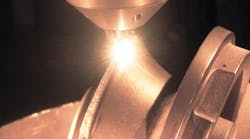3-D printing isn't magic. If nothing else, the years of hype and hyperbole we've endured around additive manufacturing have taught us that.
Industrial 3-D printing is a manufacturing process, just like any other – it's complicated, it's expensive, it requires experts and engineers and a lot of precious resources. It's not a miraculous cure-all for our manufacturing challenges.
Yet there remains in some of us this stubborn Star Trek hope that maybe, someday, a technology will come along to give us that magic, one-button complete manufacturing system the future promised.
Well, it turns out we're getting close.
At the Rochester Institute of Technology, a 20-year-old milling machine has been successfully retrofitted with a suite of metal-printing tools that allow it to build, shape, mill and finish complete parts from nothing but powder in a single, uninterrupted operation. And that is as close to big-button manufacturing as it gets.
"When you look at manufacturing processes, everybody is always interested in moving toward the big green button," explains Richard Grylls, general manager of the LENS unit at Optomec, which designed RIT's system. "What everyone wants is one operation, one set-up, just press one big green button and there you go. I think this is the technology to do it."
Optomec's system is part of a new wave of additive manufacturing technologies about to hit the market called hybrid machining. It's a new level of 3-D printing that brings us one step closer to that big-button manufacturing.
The concept is simple: by moving new additive technologies into proven subtractive machines, you eliminate transfer and set-up between two sides of the factory, which decreases engineering load while increasing efficiency and overall plant capabilities.
"You can place a component in the machine and you can pre-machine that component, you can deposit material on it and then you can finish it all in one setup," Grylls explains. "You just press that button on the front, go away, and when you come back the part is done."
Early Adopters
So far, he says, most of the direct interest in the technology has come from the oil and gas and mining industries where having the ability to cheaply and quickly repair machine components could have an incredible impact.
"Imagine," Grylls says, "instead of replacing components every time they get worn down, you can just add new material to the worn areas, machine it back down to seize, and it's literally as good as new."
Better yet, he says, adding a few alloys into the material mix being deposited onto those areas can give the piece improved wear or corrosive resistance, making it actually better and stronger than it was before the fix.
That capability – especially when it eventually moves beyond heavy machinery and into the medical device, aerospace and general manufacturing industries – could be the additive manufacturing disruption we're been waiting for.
To capitalize on that hype and potential, some of the biggest machine tool makers have already jumped into the market.
DMG Mori, Matsuura and, most recently, Mazak, have all added hybrid machines to their product catalogs, matching decades of tooling expertise with the much newer frontier of additive.
With that kind of push, it really starts to seem like something is happening with this technology.
"I think this has the potential to really change the way we make metal parts," says Terry Wohlers, principal consultant and president of Wohlers Associates.
"These hybrid machines let you do things that you couldn't do with traditional milling and that you couldn't do with additive manufacturing," he explains. "You really get the best of both worlds."
Looking at the technology broadly, it's enough to rekindle that old, early-hype fascination with 3-D printing. And it might really work out… but not quite yet. Like stand-alone industrial printing, the hybrid machines are still early in development with many kinks to work out and a big, wary market to convince.
Hold the Hype
"The hype is easy to follow, but implementing complex machines like these takes time," Grylls says.
"It's not just a matter of adding and laser and a thing that spits out powder to a machine tool," he explains. "There's a lot of intelligence required – you need intelligent software on the machine, you need vision system and automated tool path generation systems and possibly smart tooling, too."
A lot of technologies and a lot of automation go along with this super-simple, big-green-button printing, and a lot of things have to come together to make this work. And that's not so super simple.
"The software needed to optimize deposition is no trivial thing," Wohlers notes. "It's a big technological hurtle many of these companies still have to overcome."
But that is a hurtle, he says, that will soon be overcome. And when it does, the impact could be huge.
"It's still going to be another three-to-five years before we really see a significant adoption by significant companies doing significant things," Grylls explains. "By nature, these manufacturing industries are slow moving and conservative and we certainly have our own challenges ahead of us in terms of technology."
"But when all of these things come together, what we will finally have something close to that notion of the big green button system. That's really what we're driving toward," he said. "It's a pretty exciting time. "



